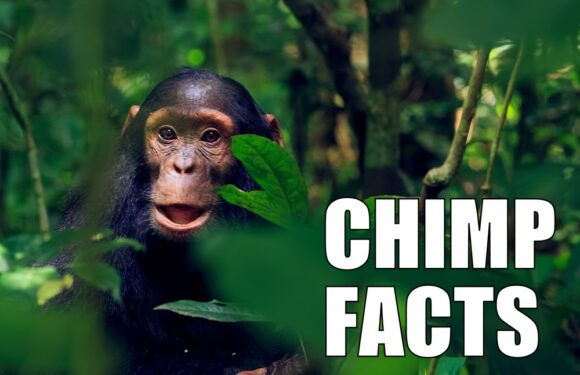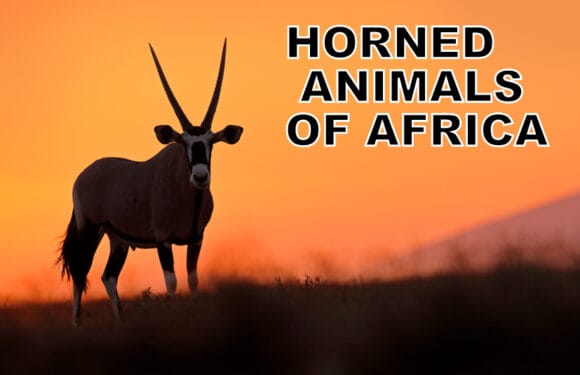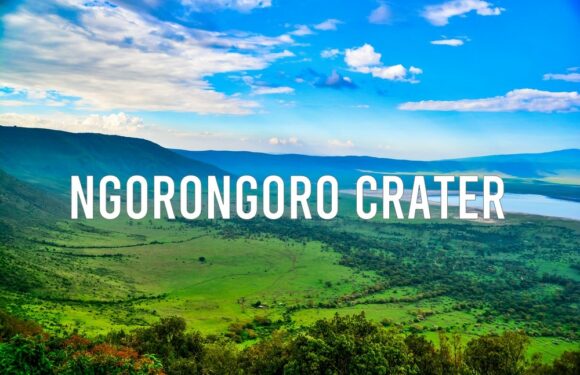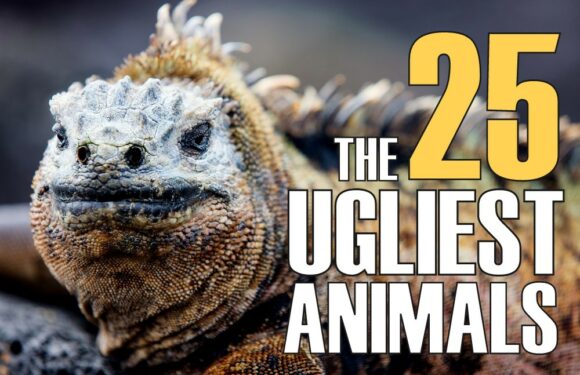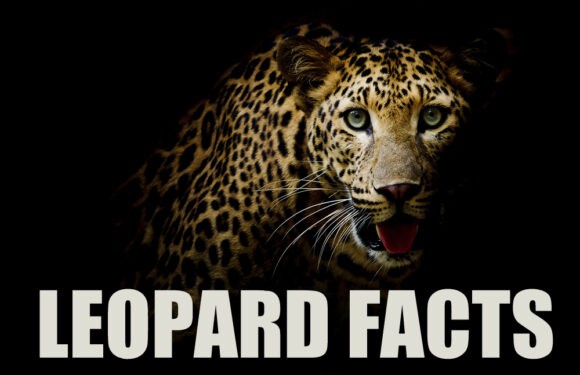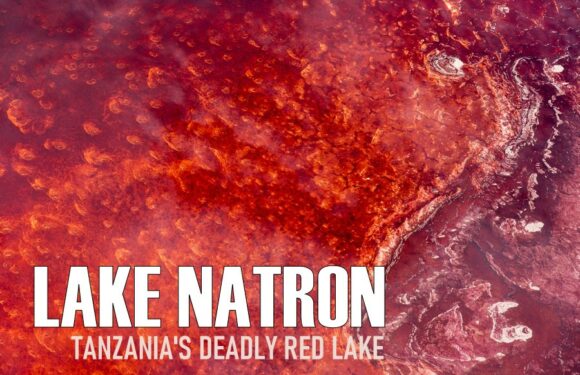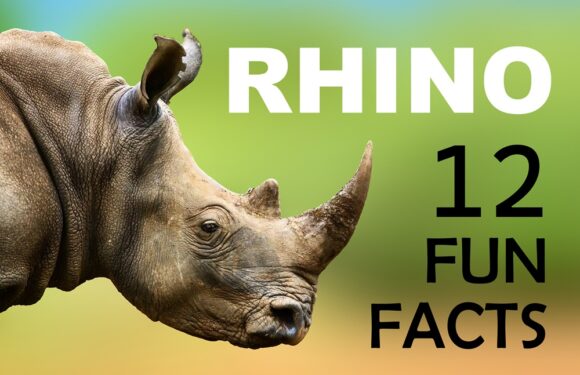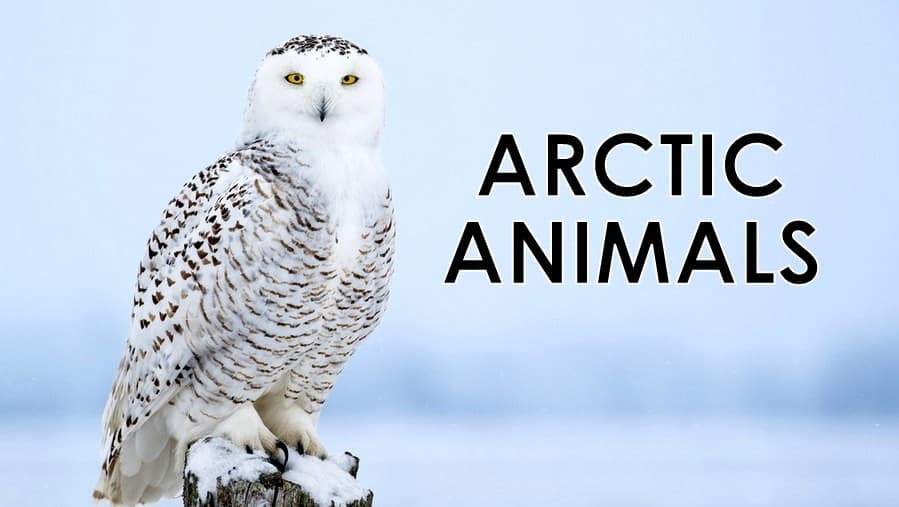
The Arctic is a vast icy wilderness at the top of the world. It is home to a unique group of animals that has adapted to thrive in its extreme conditions.
Where is the Arctic?
The Arctic encompasses the area around the Earth’s North Pole. It spans across parts of eight countries: Canada, Greenland, Iceland, Norway, Sweden, Finland, Russia, and the United States. This region also includes the Arctic Ocean, adjacent seas, and parts of the landmasses located within the Arctic Circle, an imaginary line situated at approximately 66.5° north of the Equator.
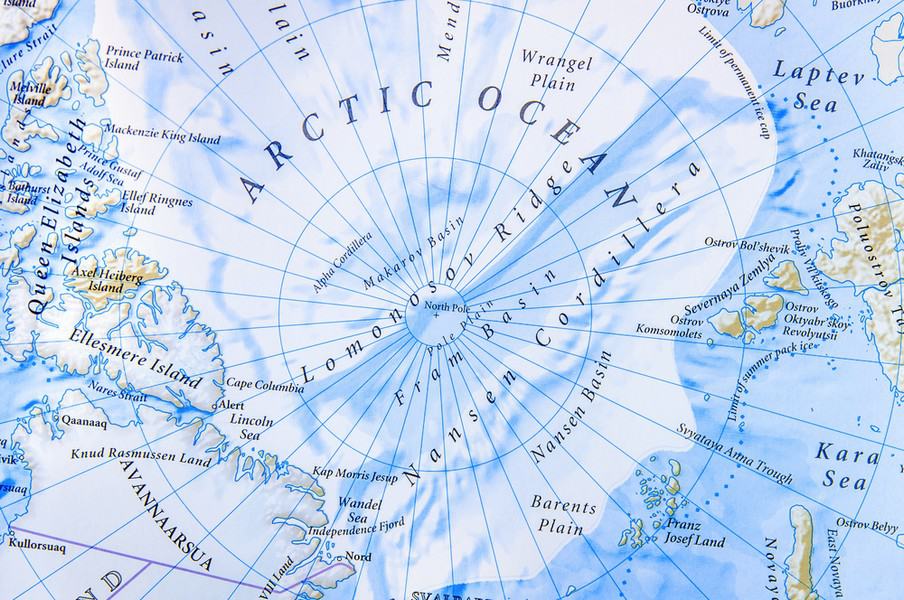
Unlike the Antarctic, which is a continent surrounded by ocean, the Arctic is a frozen ocean surrounded by continents. This geographic distinction contributes to its diverse ecosystems and habitats.
Key features of the Arctic include:
- Midnight Sun and Polar Night: The Arctic experiences the phenomenal natural occurrences of the Midnight Sun in summer, when the sun remains visible at midnight, and the Polar Night in winter, when the sun doesn’t rise above the horizon for months. This affects the life cycles of the wildlife in the region.
- Climate and Ice: The Arctic is characterized by its cold climate, which varies from sub-zero temperatures in winter to brief, cool summers. Sea ice covers much of the Arctic Ocean, expanding in the winter and retreating in the summer.
- Flora and Fauna: Despite the harsh conditions, the Arctic is home to a rich biodiversity. Its cold waters are teeming with life, supporting a variety of marine species such as whales, seals, and polar bears. The tundra blooms with hardy species of flora during the short summer, providing sustenance to land animals like reindeer and the Arctic fox.
- Indigenous Peoples: The Arctic is a homeland to indigenous peoples that have inhabited these lands for thousands of years, developing cultures and livelihoods adapted to the challenging environment.
What Adaptations Do Arctic Animals Have?
Arctic animals exhibit interesting adaptations that enable them to survive and thrive in one of the planet’s most hostile environments.
Insulation
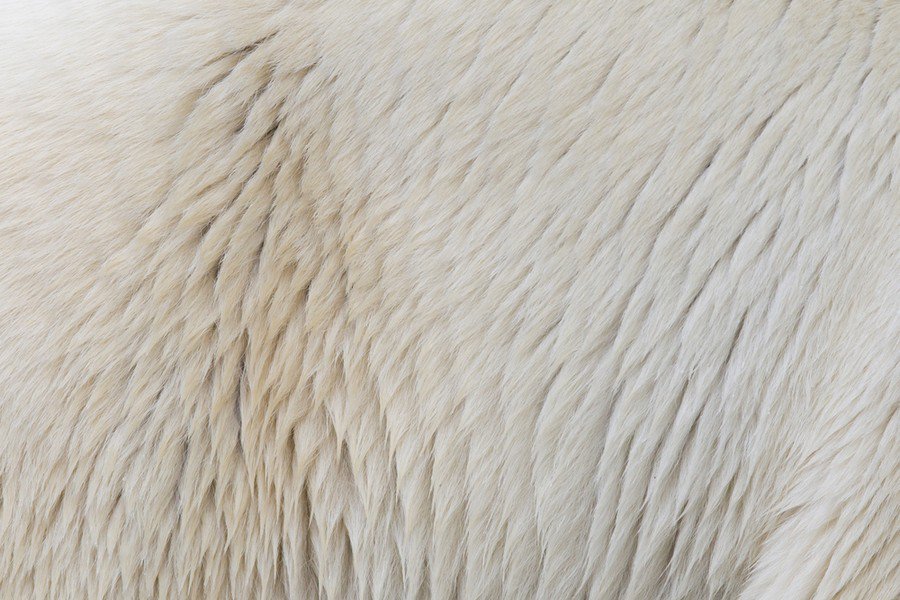
A fundamental adaptation is the development of specialized insulation to combat the cold. Many mammals have thick fur coats that trap warm air close to their bodies. Underneath this fur, a layer of fat or blubber provides additional insulation. For example, the polar bear’s fur is not only thick but also translucent, allowing sunlight to penetrate to the black skin beneath, where it can be absorbed as heat.
Some Arctic animals have developed physiological adaptations to conserve heat. The narwhal has a counter-current heat exchange system in its fins, which minimises heat loss in the cold waters of the Arctic Ocean. Meanwhile, many Arctic birds have a similar system in their legs, allowing them to stand on ice without losing excessive body heat.
Camouflage
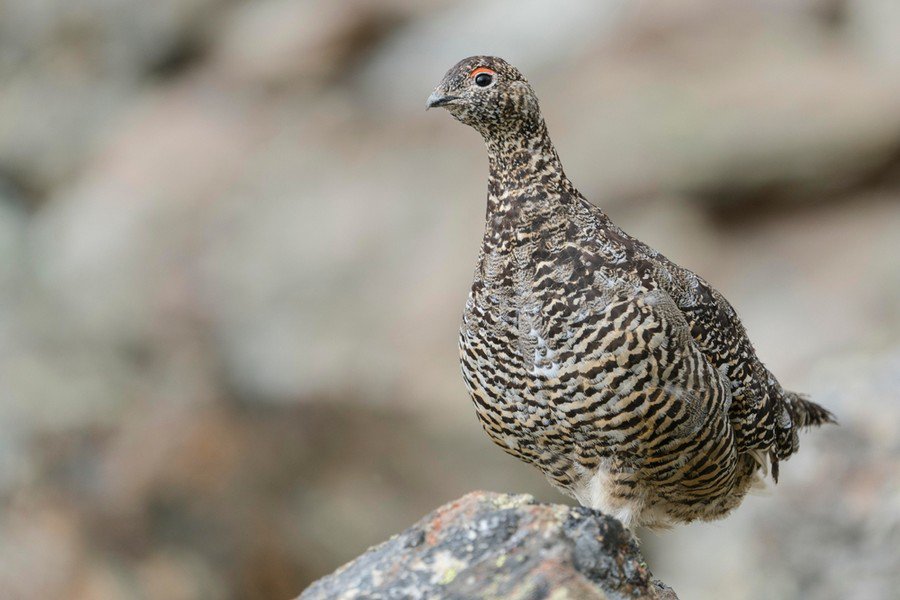
The Arctic is often blanketed in snow for large parts of the year. This varying landscape punctuates the need for different camouflage during varying seasons. The Arctic hare and the ptarmigan, a bird species, change color—from brown or gray in the summer to white in the winter—blending seamlessly into their surroundings and evading predators.
Dietary Flexibility
The scarcity of food in the Arctic, particularly during the winter months, has led animals to adopt a flexible approach to their diet. Opportunistic feeding strategies are beneficial for their survival. The Arctic fox, for instance, will eat practically anything it can find, from lemmings to fish to berries.
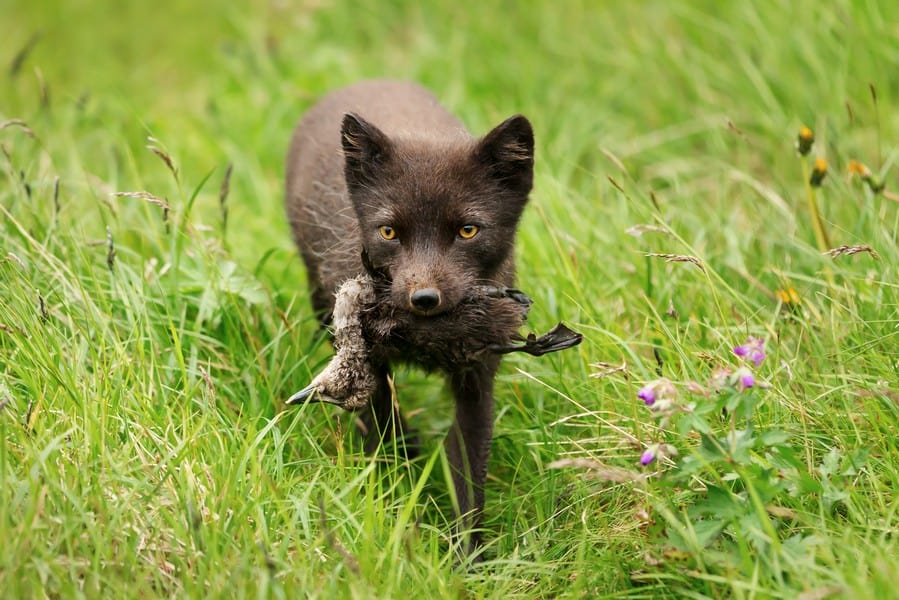
Reproductive Strategies
Many polar animals, including caribou, migrate hundreds or thousands of miles to find food, mate, or give birth in more favourable conditions. The timing of reproduction is often aligned with periods of resource abundance, ensuring that offspring have access to the summer’s bounty of food.
What Animals Live in the Arctic?
Polar Bear
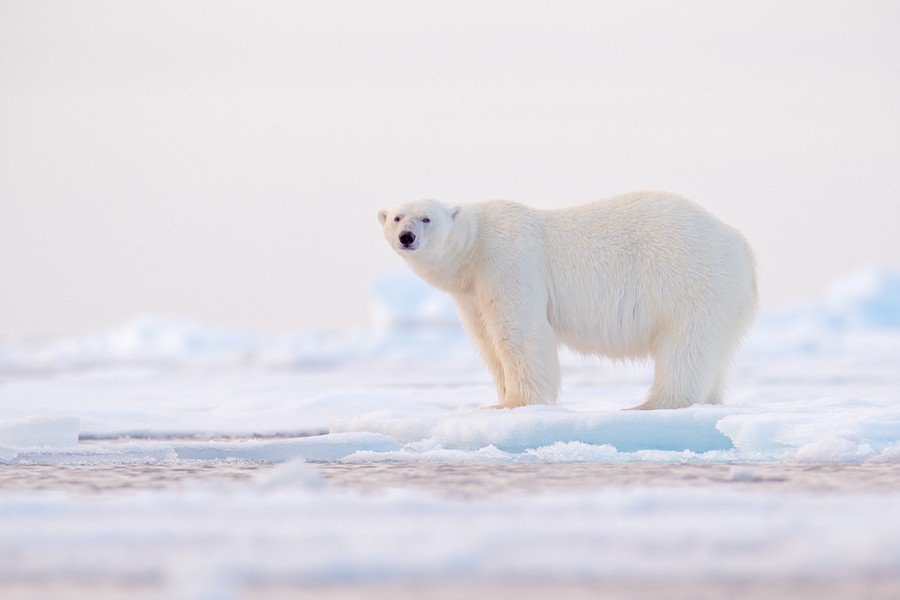
As the apex predator of the land, the polar bear is a symbol of strength and endurance. They are primarily seal hunters, and their physical adaptations make them superbly equipped for this task. Polar bears wait patiently at seal breathing holes. When a seal surfaces to breathe, the bear smashes the ice with its massive front paws, grabbing the seal in a swift, fatal motion.
Polar bears possess powerful limbs and large, paddle-like paws, which allow them to swim with ease and agility, covering distances of up to several miles. Their forepaws, used for propelling through water, can measure up to 12 inches (30 centimeters) across, providing the necessary thrust to navigate and chase after prey.
Their thick layer of blubber, essential for insulation, also adds to their buoyancy in water, enabling them to silently stalk seals near ice floes or breathing holes. Polar bears have an acute sense of smell, capable of detecting seals nearly a mile away (1.6 kilometers) and beneath several feet of compacted snow and ice.
Arctic Fox
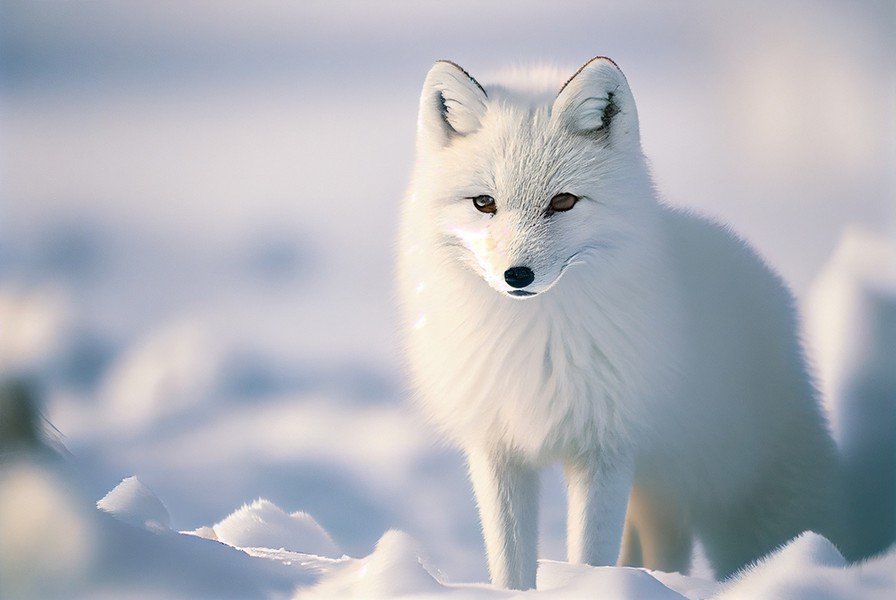
The Arctic fox has one of the warmest fur of any animal, allowing it to withstand freezing temperatures as low as -58°F (-50°C). This insulation is complemented by a compact body shape, with a short muzzle, ears, and legs to minimize heat loss. The fur changes color with the seasons—white in winter to blend seamlessly with snow and gray or brown in summer to match the tundra’s rockier, barren landscape.
In terms of behavior, the Arctic fox is a versatile predator and scavenger. Its diet varies from small mammals like lemmings—which can constitute up to 90% of its diet in some areas—to birds, eggs, and even carrion. It has a keen sense of hearing, allowing it to locate and catch prey moving beneath the snow. During winter, it will often follow polar bears to scavenge leftovers from their hunts, showcasing its efficient feeding habits.
Walrus
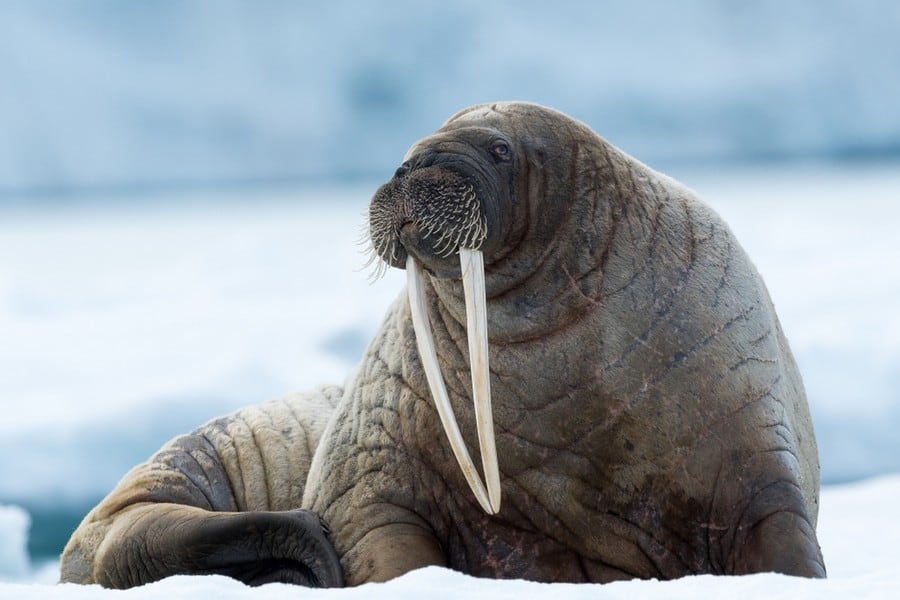
These large marine mammals are easily recognized by their distinctive tusks, which can exceed a length of 3 feet (about 1 meter). These tusks serve multiple purposes: they are used in combat amongst males for dominance and mating rights, assist in hauling their considerable bulk out of the water onto ice floes, and help the walrus to break through ice to access breathing holes.
A walrus’s body is almost tailor-made for life in frigid waters. On average, male walruses weigh between 1,800 to 3,700 pounds (about 800 to 1,700 kilograms), while female walruses are smaller, typically weighing between 880 to 2,750 pounds (about 400 to 1,250 kilograms). Their large body mass and thick layer of blubber, which can be as much as 6 inches (15 centimeters) thick, provide insulation against the cold.
These animals are benthic feeders, diving to the ocean floor to search for food. Their diet consists mainly of bivalve molluscs, such as clams, which they detect with their sensitive whiskers or vibrissae. Walruses suck out the soft parts of their prey with a powerful aspiration force, leaving the shell intact. Occasionally, they may also consume other types of invertebrates, small fish, and even seals.
Narwhal
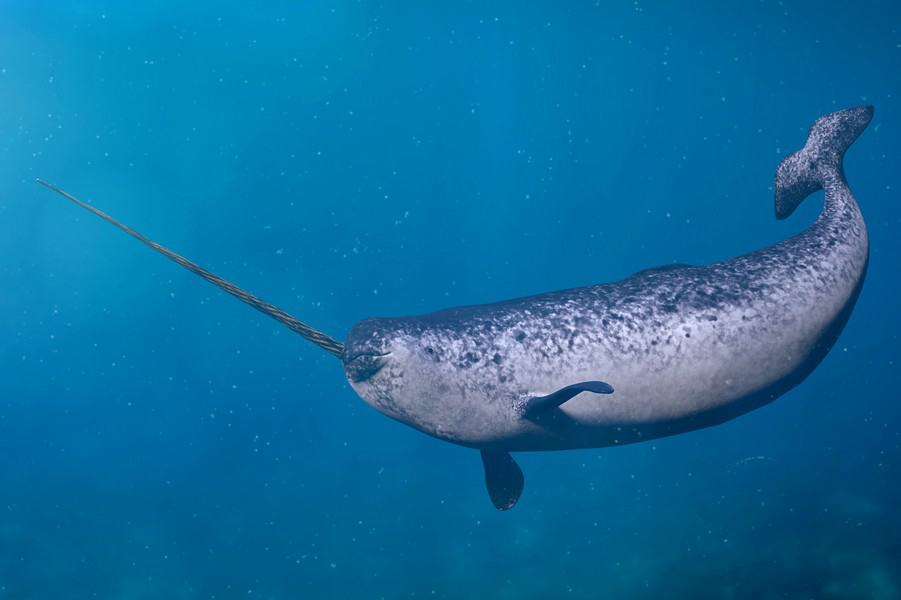
Often referred to as the ‘unicorns of the sea’, narwhals remain one of the Arctic’s most mysterious and captivating species. Their most prominent feature is the long, spiral tusk that protrude from its head, which are actually elongated teeth. The upper left canine protrudes through the upper lip and grows up to 10 feet (about 3 meters) in length. This tusk serves as a tool for establishing social hierarchy and possibly sensing environmental changes.
Narwhals have a mottled grey-blue, white, and black body, which camouflages them in the water. They lack a dorsal fin—a trait thought to aid in navigating icy waters—and possess a thick layer of blubber for insulation against the cold. Narwhals can dive up to 4,900 feet (1,500 meters) in search of food, making them one of the deepest diving marine mammals.
Snowy Owl
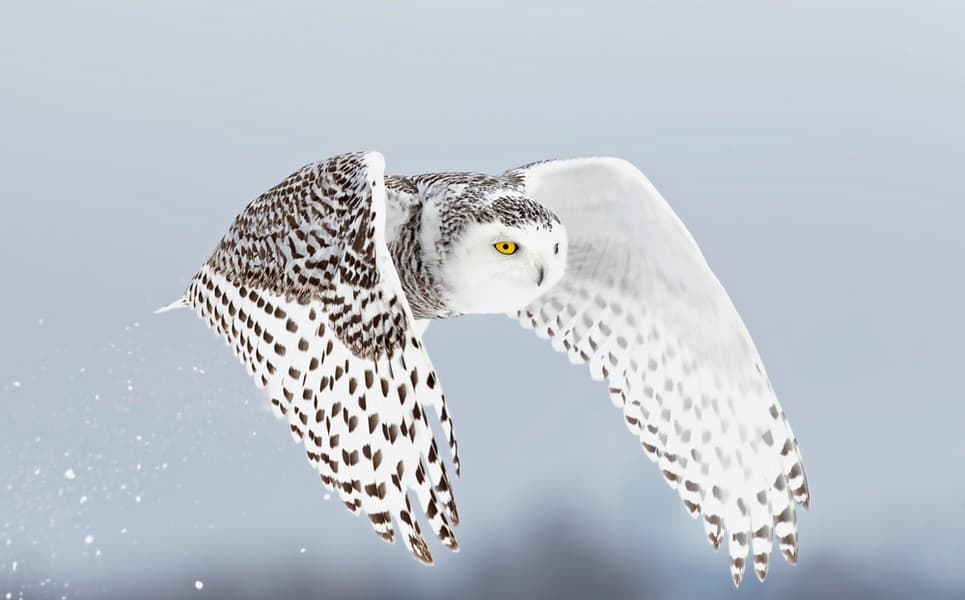
Snowy Owls are the quintessential symbol of the Arctic’s avian life. It has predominantly white feathers, interspersed with varying amounts of black markings, whichprovide excellent camouflage against the snow. Females typically exhibit more dark markings than males, who may become almost completely white with age. This species has a round head, lack of ear tufts, and powerful talons.
One of the most significant adaptations of the snowy owl is its ability to hunt both day and night, which is unusual for an owl. The Arctic’s continuous daylight during the summer months necessitates this diurnal and nocturnal activity. Their diet is versatile, primarily consisting of small mammals, with a particular preference for lemmings. A single owl can consume up to several lemmings a day, or up to 1,600 lemmings a year.
Caribou (Reindeer)
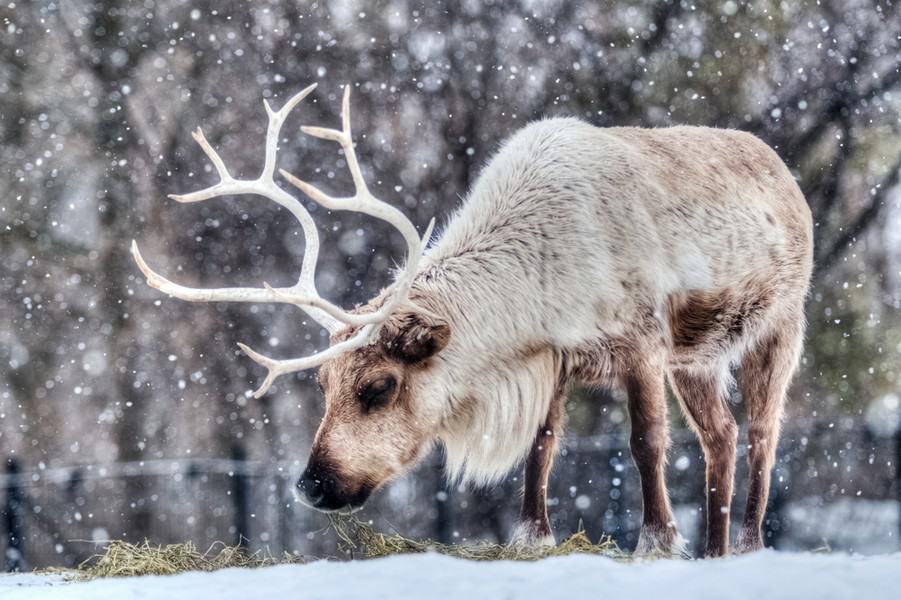
Caribou, known as reindeer outside of North America, are synonymous with the Arctic landscape. These large, hoofed mammals are built for survival in cold climates. They travel across the tundra, covering up to 3,000 miles (4,828 kilometers) annually, the longest migration of any terrestrial mammal. They travel in big herds that can number in the thousands, creating one of nature’s most spectacular displays.
Caribou are distinguished by their large, branching antlers, which are present in both males and females—a unique trait among deer species. Their coats are thick and woolly, providing insulation against the cold, and also change color with the seasons to offer better camouflage. The design of their hooves changes seasonally as well; broad and flat in the summer to support them on soft, marshy ground, and sharper-edged in the winter for piercing through snow to find food.
Beluga Whale
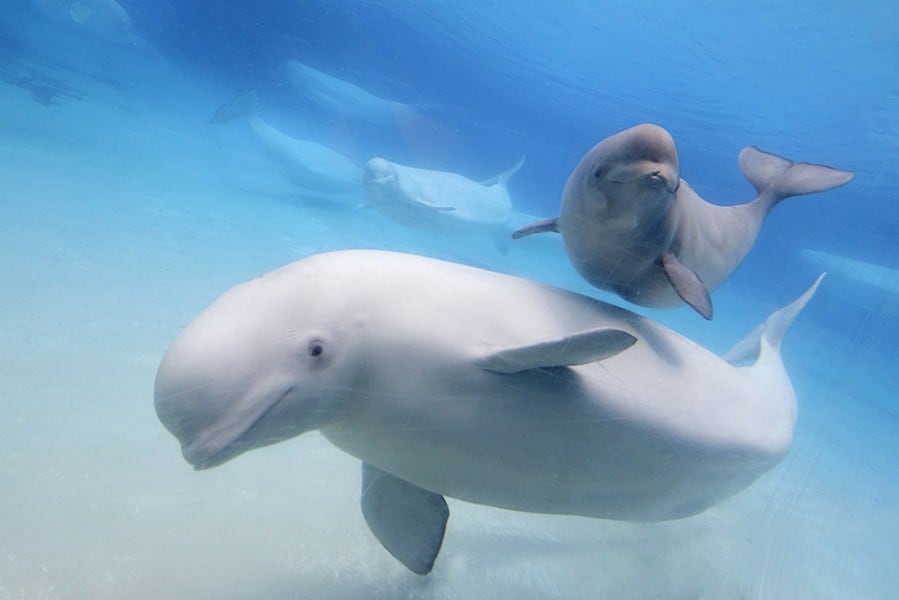
The beluga whale is a small whale species found in the Arctic and sub-Arctic waters. They have a distinctive white color and bulbous forehead, called a “melon.” Unlike other whale species, belugas have a flexible neck, allowing them to nod and turn their heads in all directions. This flexibility aids in their echolocation abilities, allowing them to navigate and hunt in the murky waters of the Arctic.
Known as the “canaries of the sea,” belugas are highly vocal creatures that use a wide range of clicks, whistles, and clangs to communicate. These social animals often travel in pods and have a thick layer of blubber that accounts for up to 40% of their body weight, providing insulation against the cold waters.
Arctic Hare
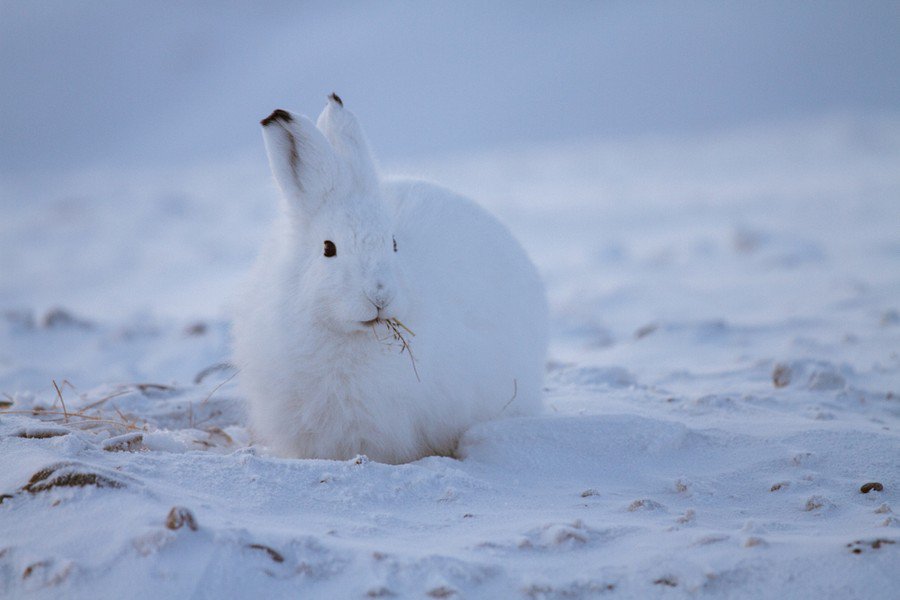
Arctic hares are built for life in the cold. It survives with a coat that changes color with the seasons to provide camouflage against predators. Capable of running up to 40 mph (64 kph), these hares have powerful hind legs that not only propel them quickly but also allow them to stand and survey their surroundings for predators.
Arctic hares have shorter ears than their more temperate cousins to conserve body heat and large, hairy feet that function as natural snowshoes. Its diet consists of woody plants, mosses, and lichens in winter, switching to buds, berries, leaves, and flowers in the summer months. They dig through snow to access buried food sources during long winters.
Musk Ox
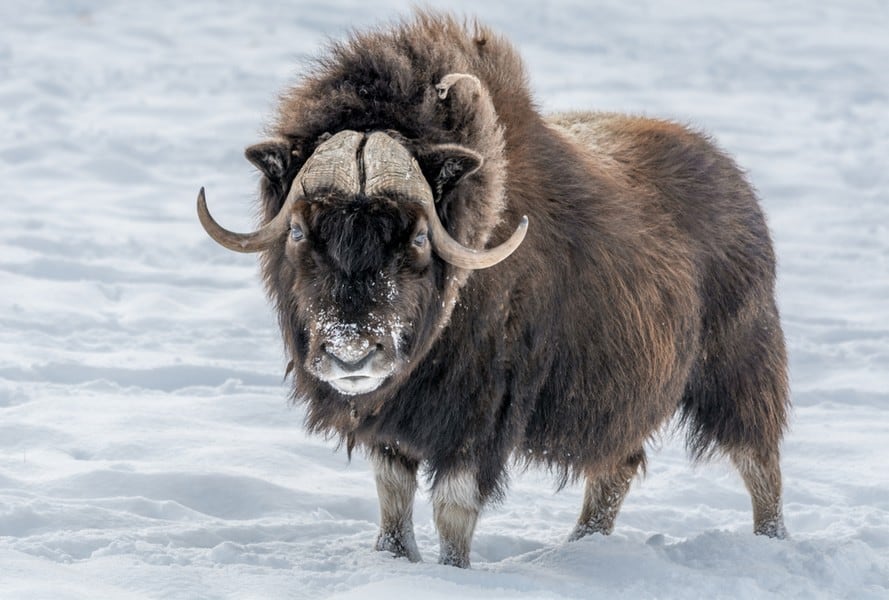
The musk ox is one of the strongest animals on Earth. Roaming the tundra of Greenland, Canada, Alaska, and Siberia, these animals are living relics of the Ice Age. They share the landscape with woolly mammoths and saber-toothed tigers.
Musk oxen are notable for their dense fur, comprising a long, coarse outer layer and a soft, insulating undercoat known as qiviut. Qiviut is one of the warmest fibers on earth, eight times warmer than sheep’s wool and finer than cashmere. It enables musk oxen to endure the extreme cold of the Arctic winter.
Musk oxen are social creatures, forming herds that can range from a few individuals to over a hundred. These herds are structured hierarchically and are led by a dominant female. In the face of threats, musk oxen form a defensive circle around the young, horns outward, to fend off attackers.
Arctic Tern
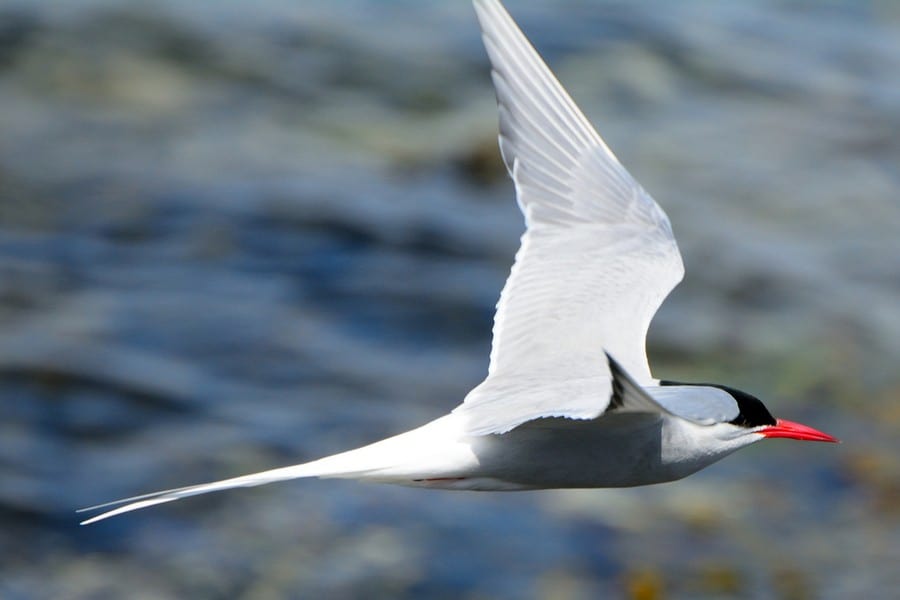
The Arctic tern is reknowned for its epic migratory journey, the longest of any animal. Each year, this slender, graceful bird travels from its breeding grounds in the Arctic to the Antarctic and back, covering an astonishing 25,000 miles (about 40,233 kilometers).
With a sleek body, long, narrow wings, and a sharp, pointed beak, the Arctic tern is perfectly designed for a life spent mostly in flight. Its light frame and aerodynamic shape allow it to glide effortlessly over oceans. The bird’s plumage is predominantly grey and white, with a black cap, offering camouflage against the sea and sky. Its diet consists mainly of fish and small marine invertebrates.
Red Fox
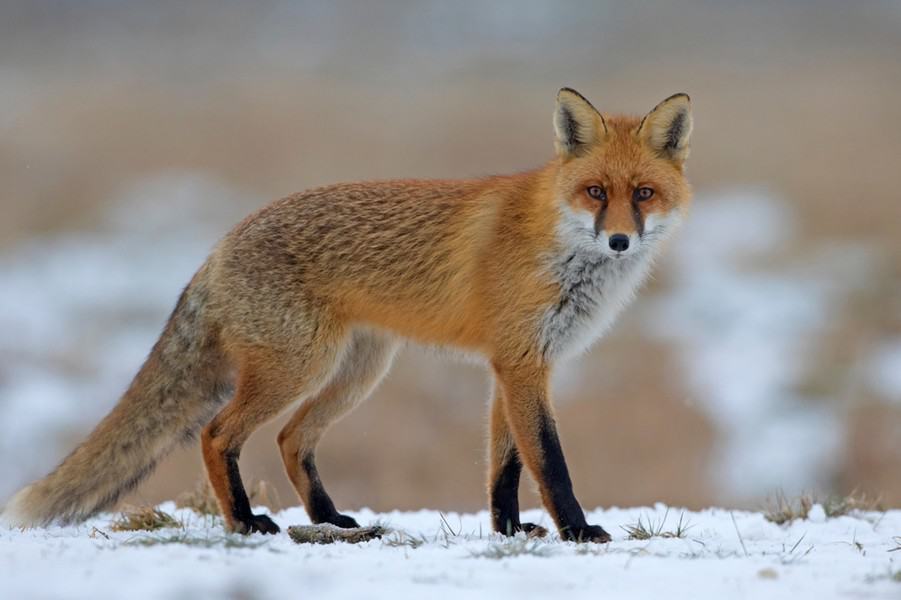
The Red Fox is perhaps the most widespread and adaptable of all canids, inhabiting diverse environments across the Northern Hemisphere. They have distinctive red-orange fur, pointed ears, and a bushy tail. Red Foxes are omnivorous and have an incredible ability to find food, from rodents to fruits and human waste. While primarily solitary hunters, Red Foxes can also form pairs during breeding season as well as gather in larger groups when resources are abundant.
Canadian Lynx
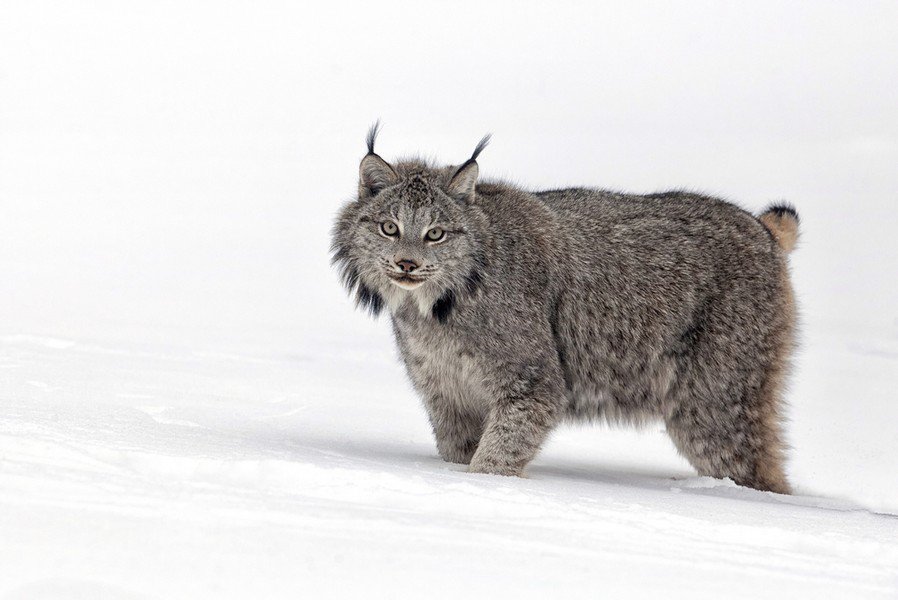
The Canadian Lynx is a silent and elusive predator of the northern forests. Adapted to cold, snowy environments, its thick fur and broad footpads make it an efficient hunter in its preferred habitat of dense boreal forests. It has tufted ears, a short tail, and large paws. Specializing in hunting snowshoe hares, the Canadian Lynx’s population cycles are closely linked to the abundance of its prey. These lynxes lead solitary lives, marked by territoriality and nocturnal hunting trips. Their stealth and camouflage, along with a preference for remote wilderness, make sightings a rare occurrence.
Moose
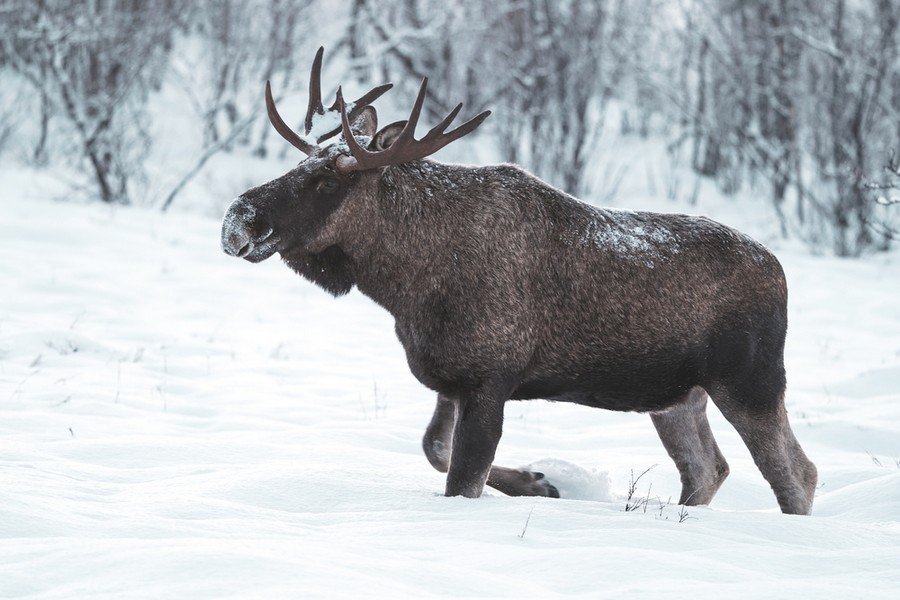
Moose are the largest of all deer species. Adult males, known as bulls, can reach heights of up to 6.5 feet (2 meters) at the shoulder, with their antlers spanning an impressive width of up to 6 feet (1.8 meters) from tip to tip. These animals can weigh anywhere from 800 to 1,500 pounds (360 to 680 kilograms). Moose have a unique ability to feed underwater, thanks to valves that close their nostrils when submerged. Their diet consists of vegetation and aquatic plants. Moose face challenges from habitat fragmentation and climate change, which impact their ability to find suitable feeding and breeding grounds.
Ermine (Stoat)
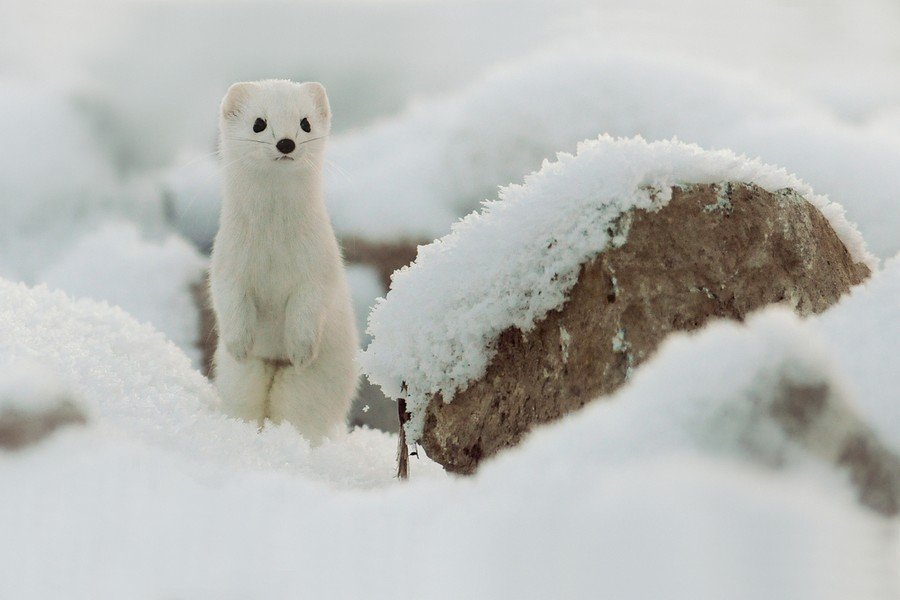
The Stoat, also known as the Ermine in its winter coat, is a small yet fierce predator of the Arctic tundra. During the summer, its fur is a sleek brown with a creamy underbelly, but as winter approaches, it transforms into a stunning white, except for the tip of its tail, which remains black. This camouflage allows it to remain inconspicuous against the snow while hunting. Ermines are versatile hunters, preying on rodents, birds, and occasionally larger game, displaying remarkable agility and cunning in their pursuit. Their reproductive strategy features delayed implantation, where fertilized eggs pause development until conditions are favourable, ensuring that young are born during times of abundance.
Arctic Wolf
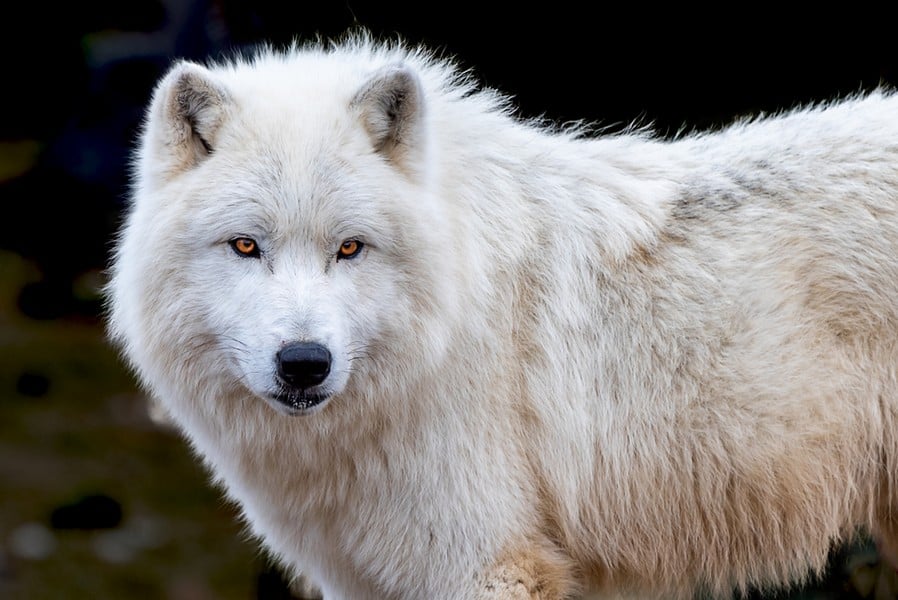
The Arctic Wolf is a subspecies of the Gray Wolf. Adapted to life in the harsh polar environment, it sports a thick, white coat that provides insulation and camouflage. Living in packs led by an alpha pair, Arctic Wolves exhibit sophisticated social structures and cooperative hunting strategies that allow them to take down large prey like musk oxen and caribou. Unlike other wolf subspecies, the Arctic Wolf rarely encounters humans, allowing it to roam vast territories undisturbed. The pack’s cohesion is paramount for survival in the extreme cold, where teamwork ensures efficient hunting and the warmth necessary during the brutal winters.
Snow Goose
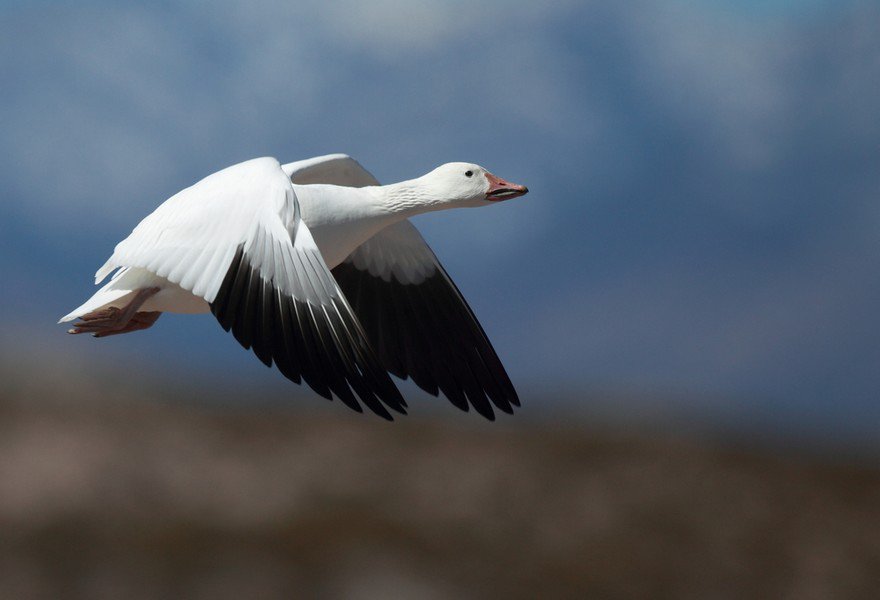
The Snow Goose is a migratory sensation. It travels thousands of miles between its breeding grounds in the Arctic and wintering areas in temperate regions. During migration, Snow Geese form large, noisy flocks that can darken the sky. They are herbivores, feeding on vegetation during summer and agricultural crops during their migration. Snow Geese have beautiful white plumage and black wingtips. They are known for their fidelity to their nesting sites and partners, with family units staying close throughout the migration.
Ribbon Seal
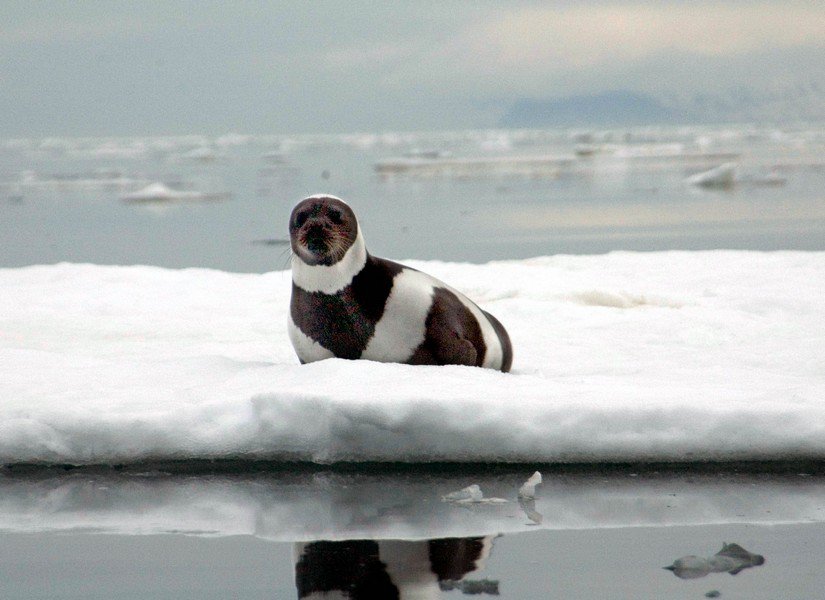
The Ribbon Seal is named for the ribbon-like bands encircling their necks, foreflippers, and body. This high contrast pattern of white stripes against dark fur make it one of the most visually unique pinnipeds in the Arctic. Ribbon Seals are well adapted to life in and around the pack ice, relying on ice floes for resting, molting, and birthing. Their diet consists mainly of fish and cephalopods, which they hunt with precision. Ribbon Seals are solitary outside of the breeding season, showcasing a preference for the open ice and deep waters that keep them largely elusive to human observation.
Lemmings
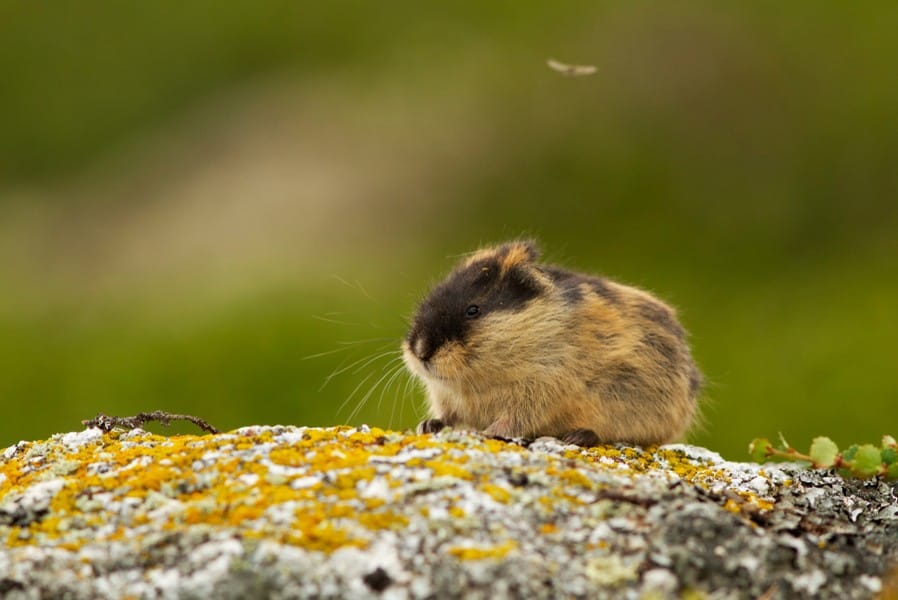
Small but mighty, lemmings are rodent species critical to the Arctic food web, serving as a primary food source for many predators. Lemmings are compact with short tails, stout bodies, and fur-covered feet, all of which are adaptations that equip them for life in cold environments. Lemmings are renowned for their fast reproductive rates, which can lead to periodic population booms.
They are prolific diggers, creating complex tunnel systems under the snow to protect against the cold and predators. Their fur changes color from brown in summer to white in winter for camouflage.
Ivory Gull
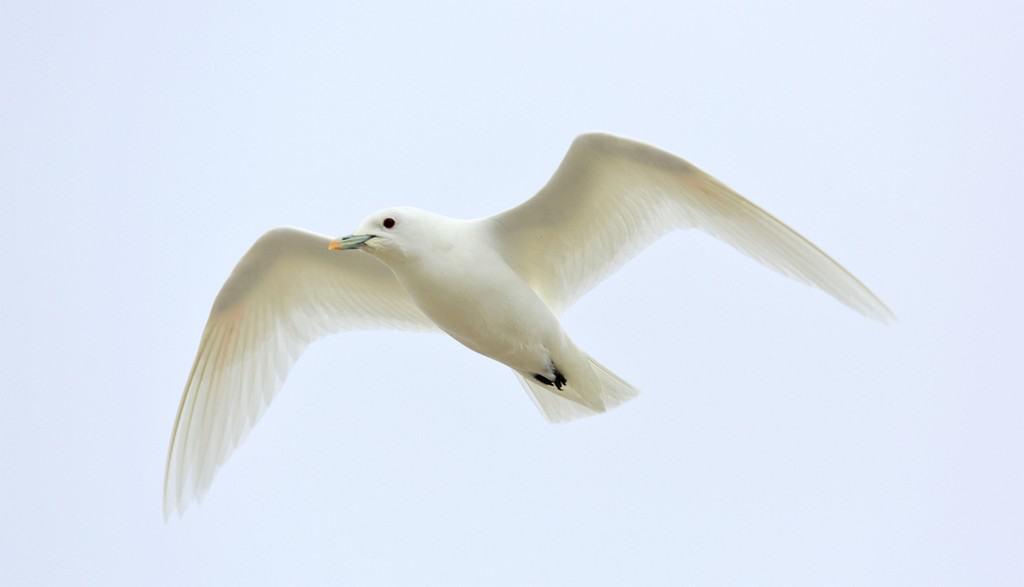
The ivory gull is a small bird that inhabits the high polar regions. Noted for its beautiful, pure white plumage and yellow legs, the ivory gull spends most of its life at sea, ice edges, or on pack ice. The ivory gull has a thick layer of feathers and relies on high-fat prey to sustain its energy needs. These birds are scavengers and will feed on the carcasses of seals and fish left by polar bears. They are also known to follow polar bears to scavenge leftovers from their kills.
Silver Fox
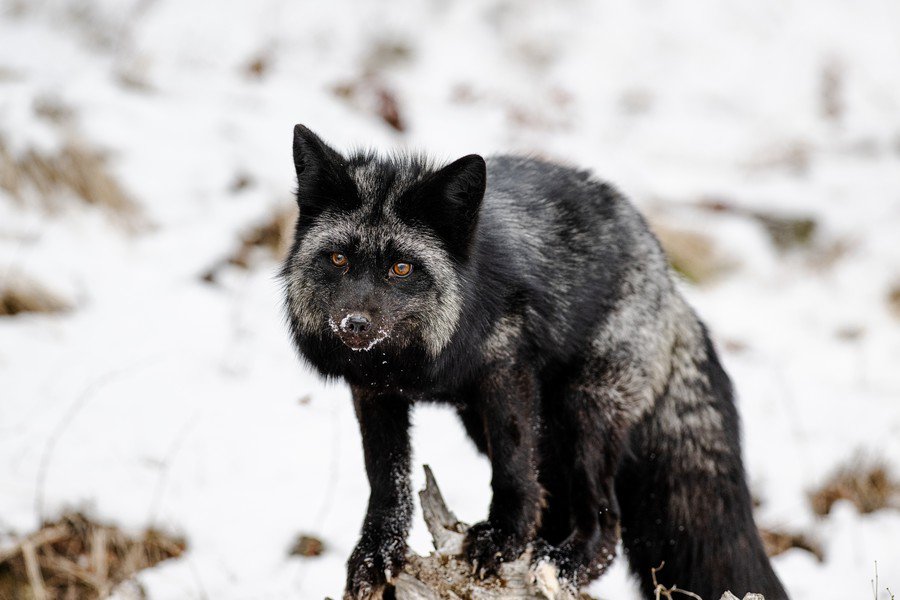
The Silver Fox is a melanistic variant of the Red Fox. It boasts a luxurious coat that gleams with silver and black hues, making it a poster child of natural beauty. These foxes share the same versatility and adaptability that characterise their red counterparts. They thrive in a wide range of environments including forests, grasslands, and the fringes of urban areas across the Northern Hemisphere. Silver Foxes feed on small mammals, birds, insects, and even fruits and vegetables. They are solitary hunters, relying on their sharp senses of hearing, sight, and smell to locate prey.
Atlantic Puffin
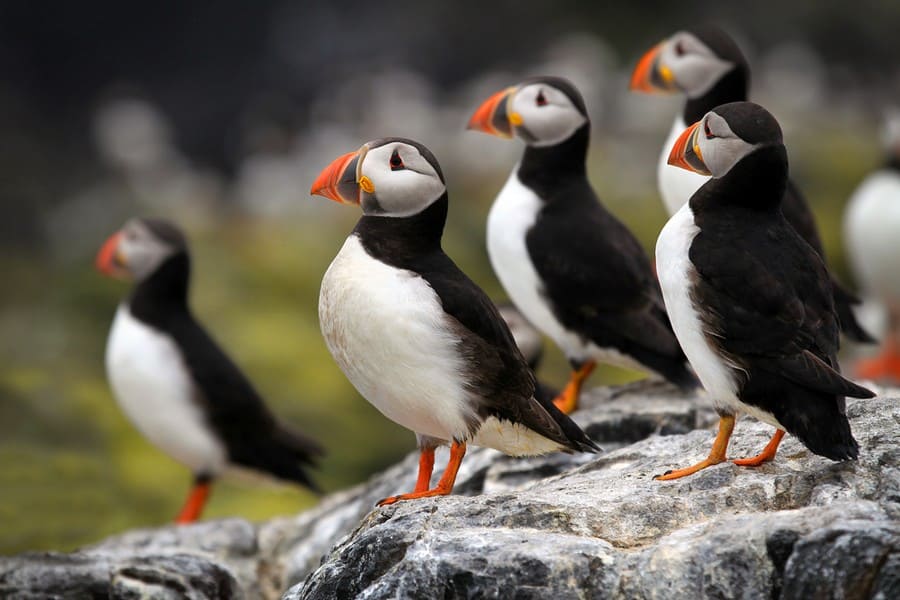
While not exclusively an Arctic animal, the Atlantic puffin breeds in parts of the Arctic Circle. They are relatively small birds, measuring about one foot (30 centimeters) in length. Their stout build belies their excellent flying and swimming ability. Their wings are used to ‘fly’ underwater, enabling them to dive and maneuver with agility, reaching depths of up to 200 feet (60 meters) in pursuit of fish.
Puffins nest in cliffside colonies, digging burrows in which they lay a single egg. Despite their clown-like appearance, puffins are hardy survivors, facing threats from sea-level rise and warming oceans.
Harp Seal
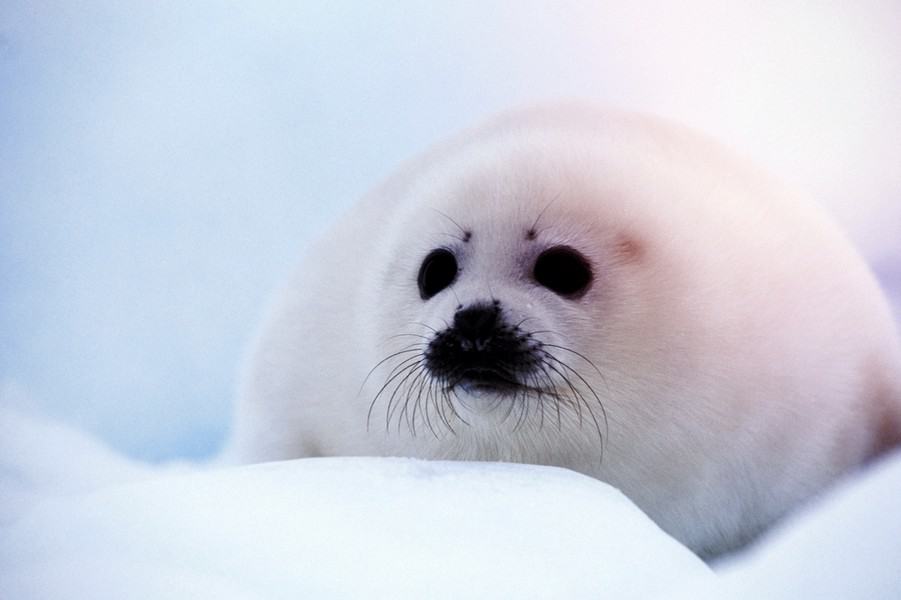
Harp seals are medium-sized pinnipeds. The adults have a dark, harp-shaped marking on their back, from which their name derives. Newborn pups are famous for their snow-white fur, which is shed as they mature, transitioning to the adult coloration.
Their habitat spans the North Atlantic and Arctic Oceans, primarily in areas associated with pack ice. During breeding season, harp seals gather in vast numbers and females give birth to a single pup. These gatherings, occurring from late February to March, are an amazing sight. The nursing period lasts only about 12 days, during which the pup gains weight rapidly thanks to the high-fat content of its mother’s milk. Following weaning, pups are left on the ice to fend for themselves. Their natural predators include polar bears, orcas, and large sharks.
Greenland Shark
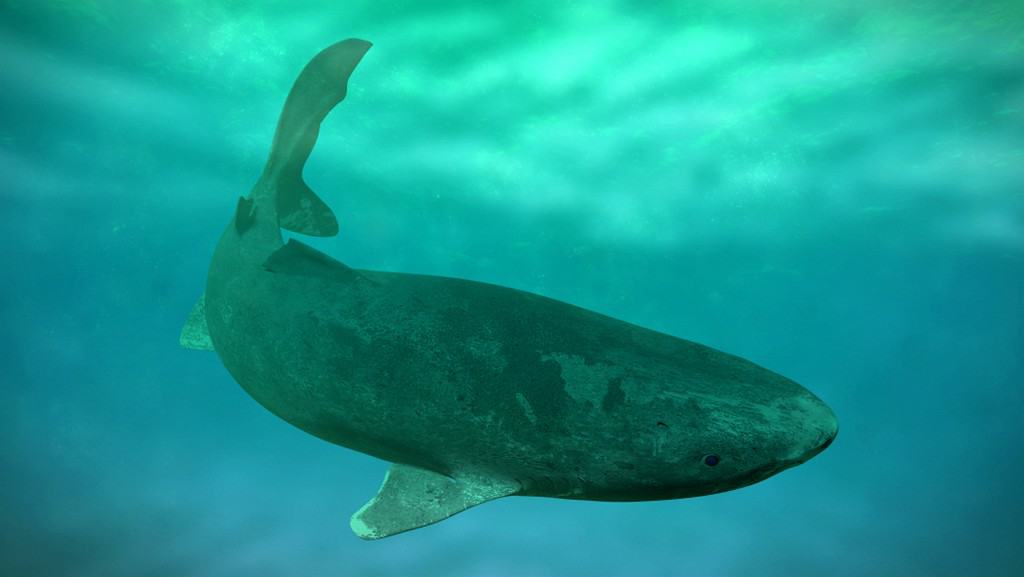
The Greenland shark is one of the Arctic’s most mysterious inhabitants, dwelling deep beneath the ice-covered waters. These sharks are among the Earth’s longest-living animals, with some individuals estimated to be over 400 years old. It is believed that they grow at an incredibly slow rate, which contributes to their extended lifespan.
The Greenland shark is a massive creature, with adult individuals typically measuring between 8 to 16 feet (2.4 and 4.9 meters) in length. Their bulky bodies, covered in rough, greyish skin, camouflage them in the murky depths they inhabit. This shark has eyes that are often clouded by a parasitic copepod, rendering them nearly blind. Despite this, they are effective predators, relying on their other senses to navigate and hunt.
The meat of a Greenland shark is toxic when fresh due to high concentrations of trimethylamine oxide. Special preparation is required in order for it to be consumed safely by humans or dogs.
Arctic Char
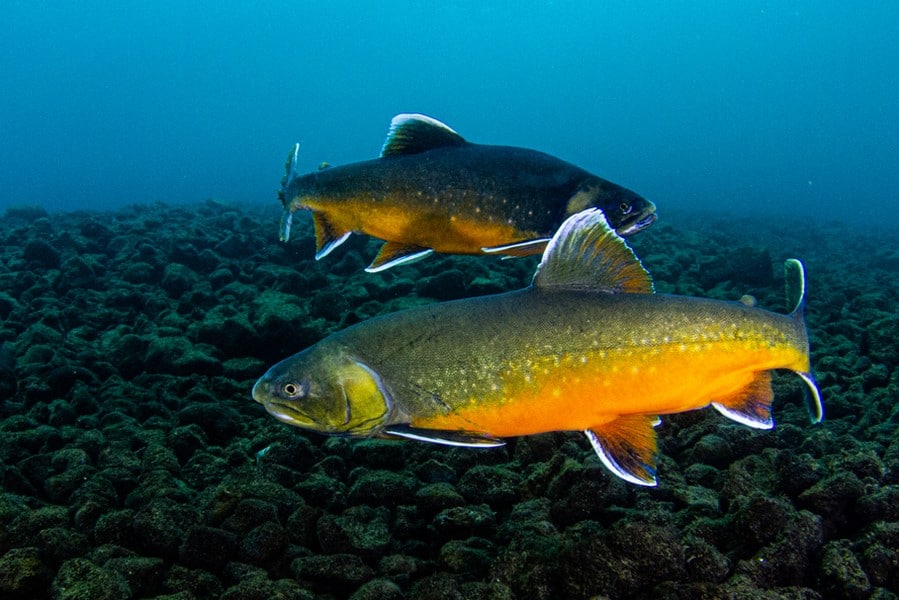
The Arctic char is a cold-water fish found in Arctic and sub-Arctic lakes and coastal waters. They are closely related to both salmon and lake trout, and like salmon, some populations are anadromous, migrating from the sea to freshwater rivers to spawn. During spawning, males exhibit bright red or orange colors. They can grow to significant sizes, with some individuals reaching over 15 pounds (about 7 kilograms).
Arctic char thrive in waters too cold for most fish species. One of the most important adaptations is the presence of antifreeze proteins in their blood. These proteins lower the freezing point of the body fluids, preventing ice crystals from forming in their tissues even in temperatures below freezing.
The Impact of Climate Change on Arctic Animals
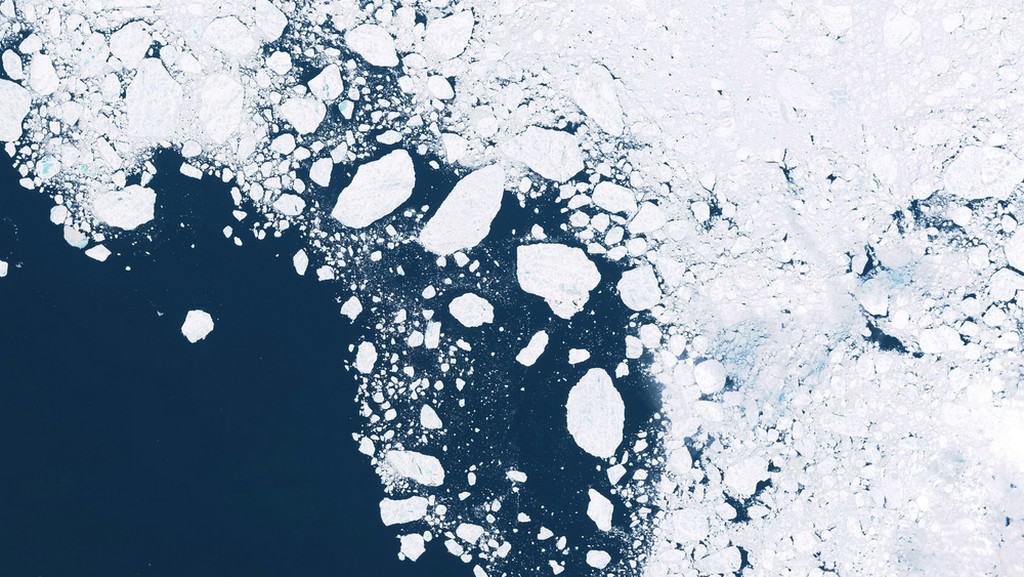
Climate change poses a significant threat to the ecosystems of the Arctic, directly impacting the survival and habitat of its wildlife. As global temperatures rise, the Arctic is experiencing some of the most rapid and severe changes, with profound implications for its flora and fauna.
One of the most visible effects of climate change in the Arctic is the reduction in sea ice. This loss of ice impacts species like the polar bear, walrus, and seals, which rely on sea ice as a platform for hunting, resting, and breeding. As the ice retreats earlier each year and forms later in the season, polar bears are forced to spend more time on land, where food is more scarce. Similarly, walruses use ice floes as resting platforms between foraging trips to the ocean floor. With the disappearance of these platforms, walruses are forced to congregate in large numbers on shores. Seals, which give birth on sea ice, face challenges in raising their young as the ice breaks up earlier in the spring.
For migratory species like the Arctic tern, which travels from pole to pole each year, the changing climate alters the timing and availability of food along migratory routes, affecting breeding success. Melting glaciers and ice caps also contribute to rising sea levels, threatening coastal nesting sites.
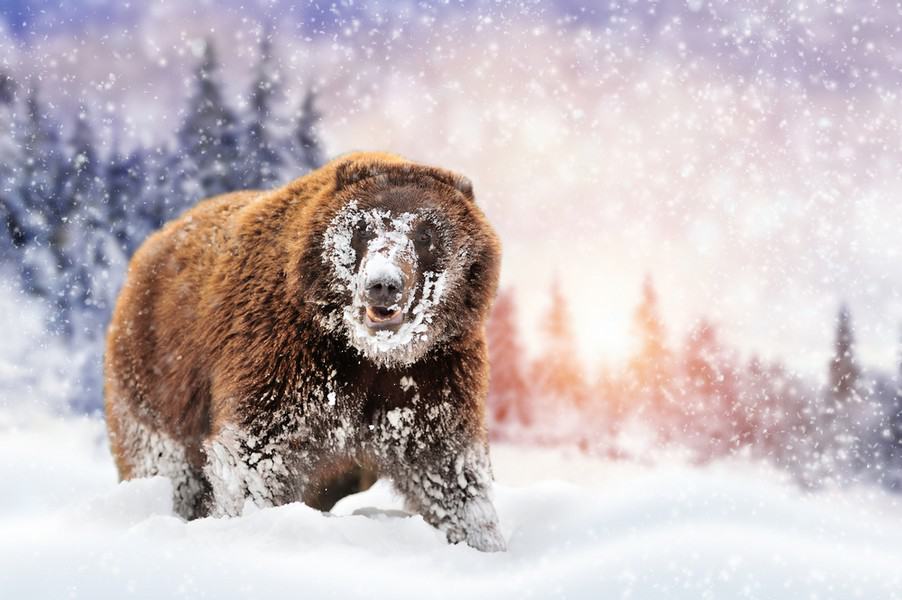
Furthermore, warmer temperatures are allowing species from more temperate zones to move northward, like the Grizzly bear, introducing new competition and diseases to which Arctic species are not adapted. This includes both terrestrial and marine species, potentially disrupting existing food webs and ecological balances.
In summary, climate change represents an urgent threat to the wildlife of the Arctic, challenging the survival of species adapted to its conditions through changes in sea ice, temperature, and ecological competition. The resilience of these species is being tested as never before, highlighting the need for comprehensive efforts to mitigate the impacts of climate change and protect the Arctic’s biodiversity.
Species List
Here’s a list of some of the animals found in the Arctic:
Land Mammals
- Polar Bear
- Arctic Fox
- Arctic Hare
- Arctic Wolf
- Musk Ox
- Moose
- Red Fox
- Silver Fox
- Caribou (Reindeer)
- Lemming
- Snowshoe Hare
- Ermine (Stoat)
- Svalbard Reindeer
- Brown Bear
- American Black Bear
- Wolverine
- Canadian Lynx
- Collared Lemming
- Dall Sheep
- Alaska Marmot
Marine Mammals
- Walrus
- Ringed Seal
- Bearded Seal
- Harp Seal
- Hooded Seal
- Spotted Seal
- Ribbon Seal
- Bowhead Whale
- Beluga Whale
- Narwhal
- Gray Whale
- Minke Whale
- Humpback Whale
- Blue Whale
- Fin Whale
- Killer Whale (Orca)
- Sperm Whale
- Narwhal
- Greenland Shark
Birds
- Snowy Owl
- Puffin
- Arctic Tern
- Snow Goose
- Ivory Gull
- Ptarmigan
- Ross’s Gull
- Little Auk (Dovekie)
- King Eider
- Red-throated Loon
- Black Guillemot
- Common Eider
- Brünnich’s Guillemot
- Northern Fulmar
- Glaucous Gull
- Sabine’s Gull
- Arctic Skua (Parasitic Jaeger)
- Long-tailed Jaeger
- Lapland Longspur
- Snow Bunting
This list is not exhaustive, as the Arctic is home to a diverse range of life, including many species of birds, marine mammals, fish, and terrestrial mammals.



















































